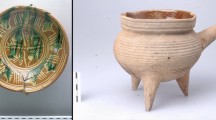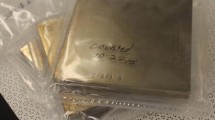Abstract
Based on purification efficiency calculations for lead distillation, we developed a combined process for the ultrapurification of archaeological lead. We obtained pilot amounts of high-purity archaeological lead and PbO with the following contents of detrimental impurities: U, <2 ppb; Th, <1 ppb; Ni, Cu, Fe, Si, Ti, Mg, Al, Mn, Cr, V, Co, < 0.1 ppm; K, Ca, Zn, Cd, Ag, Sb, < 1 ppm. Lead of such purity can be used in low-background experiments as a protective shield material and in the growth of low-background PbWO4 and PbMoO4 scintillator crystals. From an isotope ratio, we were able to identify the origin of the archaeological lead.
Similar content being viewed by others
References
Bernabei, R., Windows beyond the Standard Model, AIP Conf. Proc., 2007, vol. 942, pp. 13–18.
Tretyak, V.I. and Zdesenko, Yu.G., Tables of Double Beta Decay Data, At. Data Nucl. Data Tables, 2002, vol. 80, no. 1, pp. 83–116.
Vergados, J.D., The Neutrinoless Double Beta Decay from a Modern Perspective, Phys. Rep., 2002, vol. 361, no. 1, pp. 1–56.
Elliot, S.R. and Engel, J., Double-Beta Decay, J. Phys. G: Nucl. Part. Phys., 2004, vol. 30, pp. 183–215.
Ejiri, H., Double Beta Decays and Neutrino Masses, J. Phys. Soc. Jpn., 2005, vol. 74, pp. 2101–2127.
Avignone, F.T., Elliott, S.R., and Engel, J., Double Beta Decay, Majorana Neutrinos, and Neutrino Mass, Rev. Mod. Phys., 2008, vol. 80, no. 2, pp. 481–516.
Arpesella, C., Derbin, A., et al., Measurements of Extremely Low Radioactivity Levels in BOREXINO, Astropart. Phys., 2002, vol. 18, no. 1, pp. 1–25.
Laubenstein, M., Hult, M., Gasparro, J., et al., Underground Measurements of Radioactivity, Appl. Radiat. Isot., 2004, vol. 61, pp. 167–172.
Danevich, F.A., Scintillators in Particle Astrophysics, Trudy mezhdunarodnoi konferentsii “Inzheneriya stsintillyatsionnykh materialov i radiatsionnye tekhnologii” (ISMART-2008) (Proc. Int. Conf. Scintillation Materials Engineering and Radiation Technologies, ISMART-2008), Kharkov: ISMA, 2009, pp. 54–92.
Alessandrello, A., Cattadori, C., Fiorentini, G., et al., Measurements on Radioactivity of Ancient Roman Lead to Be Used As Shield in Searches for Rare Events, Nucl. Instrum. Methods., Sect. B, 1991, vol. 61, no. 1, pp. 106–117.
Alessandrello, A., Allegretti, F., Brofferio, C., et al., Measurements of Low Radioactive Contaminations in Lead Using Bolometric Detectors, Nucl. Instrum. Methods., Sect. B, 1993, vol. 83, no. 4, pp. 539–544.
Danevich, F.A., Kim, S.K., Kim, H.J., et al., Ancient Greek Lead Findings in Ukraine, Nucl. Instrum. Methods., Sect. A, 2009, vol. 603, no. 3, pp. 328–332.
Zdesenko, Yu.G., Kropivyanskii, B.N., Kuts, V.N., et al., Lead Molybdate: A Low-Temperature Scintillator for Detection of 100Mo Neutrinoless Double Beta Decay, Prib. Tekh. Eksp., 1996, no. 3, pp. 53–57.
Danevich, F.A., Georgadze, A.Sh., Kobychev, V.V., et al., Application of PbWO4 Crystal Scintillators in Experiment to Search for 2β Decay of 116Cd, Nucl. Instrum. Methods., Sect. A, 2006, vol. 556, no. 1, pp. 259–265.
Kovtun, G.P., Kravchenko, A.I., and Shcherban’, A.P., Preparation of High-Purity Gallium, Zinc, Cadmium, and Tellurium for Microelectronic Applications, Tekhnol. Konstr. Elektron. Appar., 2001, no. 3, pp. 6–8.
Kovtun, G.P., Shcherban’, A.P., Solopikhin, D.A., et al., Purification of Cadmium and Lead for Low-Background Scintillators, Proc. I Int. Workshop Radiopure Scintillators for EURECA (RPScint’2008), Kyiv, 2009, pp. 59–63.
Gale, N.H. and Stos-Gale, Z.A., Bronze Age Copper Sources in the Mediterranean: A New Approach, Science, 1982, vol. 216, pp. 11–18.
Gale, N.H. and Stos-Gale, Z.A., Lead and Silver in the Ancient Aegean, Sci. Am., 1981, vol. 244, pp. 176–192.
Krogh, T.E., A Low Contamination Method for Hydrothermal Decomposition of Zircon and Extraction of U and Pb for Isotopic Age Determinations, Geochim. Cosmochim. Acta, 1973, vol. 37, pp. 485–494.
Author information
Authors and Affiliations
Corresponding author
Additional information
Original Russian Text © R.S. Boiko, V.D. Virich, F.A. Danevich, T.I. Dovbush, G.P. Kovtun, S.S. Nagornyi, S. Nisi, A.I. Samchuk, D.A. Solopikhin, A.P. Shcherban’, 2011, published in Neorganicheskie Materialy, 2011, Vol. 47, No. 6, pp. 722–726.
Ballast from a Greek ship sunk near the southern coast of Crimea in the Black Sea in the first century BC.
Rights and permissions
About this article
Cite this article
Boiko, R.S., Virich, V.D., Danevich, F.A. et al. Ultrapurification of archaeological lead. Inorg Mater 47, 645–648 (2011). https://doi.org/10.1134/S0020168511060069
Received:
Published:
Issue Date:
DOI: https://doi.org/10.1134/S0020168511060069




